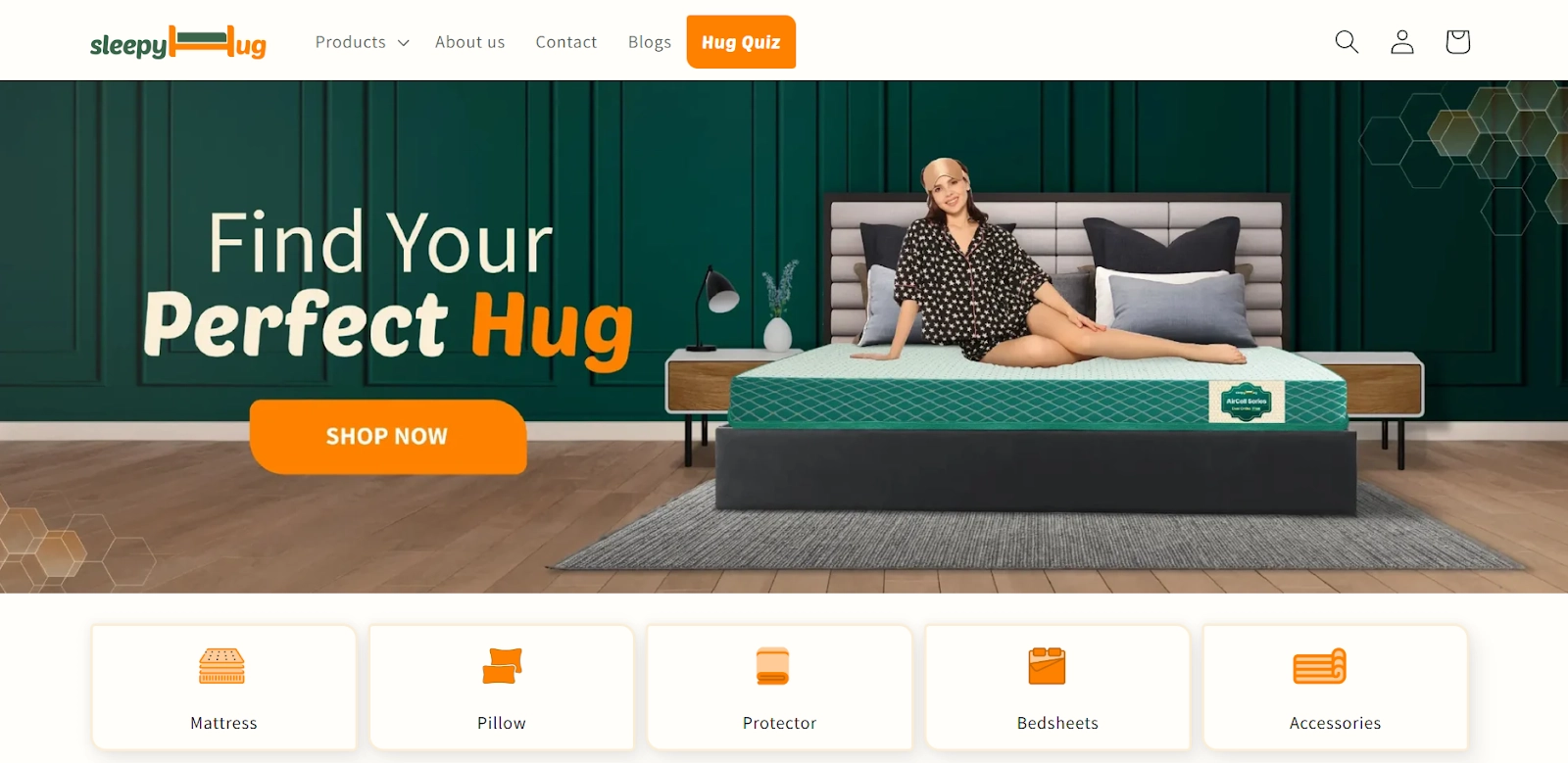Product Market Fit Example: How SleepyHug Cracked Product Innovation and Nailed Market Fit?

Most startups fail because they build products nobody wants. They spend months perfecting features and chasing funding, only to discover their market doesn't care.
But some brands, like SleepyHug play by different rules. They spend months understanding their industry, customers, and competitors to create products that fulfil genuine market demand.
When you nail down product market fit, customers don't just buy your products, they become brand advocates. You're no longer chasing buyers; they show up consistently.
But here's the challenge: finding that sweet spot where your product solves a real problem better than anything else in the market.
With GrowthJockey's strategic guidance, SleepyHug didn't just launch another mattress brand. They engineered a sleep solution that filled a genuine market gap, scaling from zero to ₹100 Cr in just 13 months.
Here's how we helped them find their product market fit and what founders can learn from this approach.
The sleeping gap: Where the Indian mattress market falls short!
Despite spending a third of their lives in bed, most Indians report poor sleep. This disconnect pointed to a clear problem with available sleep solutions. We found that there were several critical gaps in the Indian mattress market that no one was properly addressing. Some of these market gaps included:
-
Issue in price-quality: Traditional mattress brands were selling through dealers who added 25% to 40% markups. This left customers with a tough choice: either empty their wallets or settle for something that hardly offered good sleep. Many consumers were caught in this frustrating middle ground.
-
Uncomfortable mattresses: Existing mattresses turned hot quickly, developed sags, and left backs aching. People were interested in something that actually delivered comfort all night long. The desire for better sleep quality was clear, yet products fell short.
-
Confusing in-store experience: Mattress shopping was a nightmare of similar-looking models, pushy salespeople, and no way to properly test before buying. Similarly, online options weren't much better, offering little help in finding the right fit for specific sleep needs.
-
Lack of innovation: Many established players relied on outdated technologies like basic PU foam or coir. There was little focus on advanced sleep technology, such as temperature regulation or body alignment, which reflected a need for an innovative sleep solution.
Finding the right product market fit: 5 key steps GrowthJockey followed!
Even after identifying the gaps in India's mattress market, GrowthJockey wanted to be certain before launching the product. SleepyHug wasn't meant to be just another brand with affordable sleep-science mattresses, their vision was to truly transform how people sleep.

To achieve this vision, we came up and followed this product market fit framework:
1. Industry analysis and benchmarking
Often considered a common step, competitor analysis is absolutely critical when you're trying to crack a crowded market like mattresses.
So, we got deep into what mattress brands were doing both globally and in India. This wasn't just casual browsing but we studied their best-selling models, pricing strategies, marketing approaches, and product innovations with laser focus.
With that, we gained insights into what was working and where innovation was possible to build something genuinely different.
2. Customer interviews and reviews
Beyond understanding the current market landscape, we decided to hear directly from people who are going to buy the mattress and are struggling with poor sleep. Through detailed customer interviews, we discovered what really mattered when people were choosing a mattress:
-
Firmer mattresses were the go-to choice for customers dealing with back problems, as they provided better support for the spine.
-
Softer mattresses appealed to those who wanted to sink in and feel cosy, especially for pressure relief after long days.
-
High-quality materials were a must-have, with people focusing on how long the mattress would last, whether it would remain cool, and its overall comfort.
-
Getting the right size was crucial, depending on bedroom space, how someone sleeps, and whether they share the bed with a partner.
-
Good value for money topped most people's lists as they wanted comfort without breaking the bank.
On top of the interviews, we looked through thousands of customer reviews from online stores, social media, and company websites. With that, we figured that customers wanted pressure relief, spinal support, motion isolation, and temperature regulation from their mattress.
3. Hands-on testing of 300+ mattresses
While we understood what the customers wanted, it wasn’t enough to know exactly what to build or where the current mattresses were lacking. So, we actually bought and tested over 300 mattresses from top brands. Here’s what we looked at while evaluating them:
-
Material and build quality: Foam density, spring types, airflow, and fabric strength over time.
-
Comfort and support: Performance across different sleeping positions like back, side, and stomach sleepers.
-
Durability and longevity: Whether mattresses kept their form, resisted sagging, and warranty claim patterns.
-
Smart features: Sleep tracking, temperature control, and anti-snoring technology.
-
User performance: Lab test results compared against actual customer experiences.
4. Partnership with Prime Comfort
Once we determined what type of mattress would work best in the market, we partnered with Prime Comfort, a leading foam manufacturer. Prime Comfort's sleep technology expertise helped the brand create high-quality mattresses with better durability and comfort while keeping prices competitive.
Moreover, based on what customers preferred and could afford, the products were divided into three main categories:
-
Foam mattresses: Budget-friendly, long-lasting, and good support
-
Soft mattresses: Plush and luxurious feel for extra comfort
-
Memory foam mattresses: Better pressure relief and less movement transfer
5. Market launch and validation
With the product ready, the final step was winning over the market. Since the mattress industry is highly competitive, building trust is essential.
That's why our go-to-market plan focused on Flipkart first, a platform customers already trusted. This gave the brand instant access to millions of active shoppers and valuable insights into buying behaviour. It was the perfect testing ground to see if the product truly fit the market.
Furthermore, to build that crucial trust and drive sales, we even prioritised what customers looked for when shopping for a mattress:
-
Generous trial period with easy returns
-
Strong warranty that backed up quality claims
-
Premium features at prices that made sense
After proving successful on Flipkart and validating customer preference for their mattresses, the brand expanded to Amazon and launched its own website.
Read SleepyHug’s go-to-market strategy to see how GrowthJockey dominated a crowded industry.
The results: A mattress brand that became everyone's favourite!
Building a ₹100 crore mattress brand from scratch was no easy feat. However, starting with a clear product market fit framework helped GrowthJockey understand what the market needed. As a result, we helped SleepyHug create products that solved real sleep problems and packaged them in ways customers truly appreciated.
Within time, the brand grew rapidly from just 39 products to over 500, becoming a one-stop sleep solution for people.
But the reason that the brand went on growing is that they never stopped listening to their customers. They have built a feedback loop that allows them to constantly hear what their audience is saying.
For instance, when customers wanted different firmness options, it was quickly added. Similarly, when people asked for better cooling features, that’s what they focused on. Through this responsive approach, SleepyHug kept customers happy and coming back, ultimately turning into a brand that Indians actually wanted to bring home.
Key takeaways from SleepyHug's product market fit case study
Product market fit is the best way to ensure your solution solves a real problem and meets what customers actually want. It helps you position your brand strategically, gain market traction faster, and build sustainable long-term growth.
SleepyHug's journey from new brand to mattress leader shows just how important getting the right product is.
Here are three key lessons from their product market fit case study that you can use:
1. Combine strong research with rapid iteration
Begin by learning what your audience really needs, but don't spend forever planning. The mattress brand studied competitors carefully but also launched products quickly to see how people responded. This balanced approach prevents both building the wrong product and taking too long to reach the market.
2. Use customer feedback to improve features
After launching, pay attention to how people use your product. Just like the mattress brand, they kept track of reviews, reasons for returns, and most popular purchases. This feedback helped them make their mattresses better based on what customers actually wanted and were using, not just what they thought people might want.
3. Attach trust-building elements to your offerings
Even excellent products face doubt, especially when they come from new companies. So, the brand offered free trials, strong warranties, and clear pricing right from the beginning. These trust signals removed barriers to purchase and increased adoption, allowing faster validation of their product market fit.
Final words: The GrowthJockey advantage
Most brands think they understand their market, but real success comes from a deliberate process of listening, testing, and iterating until you crack the code.
SleepyHug stands out among product market fit examples because it did precisely that. They didn't launch based on assumptions, but they researched competitors, tested 300+ mattresses, and validated customer needs before building anything.
But here's what made their success inevitable: having the right expertise at every step. With GrowthJockey's venture-building support, SleepyHug didn't have to tackle everything alone.
While other startups struggle with market analysis and customer research, SleepyHug had market research, product development, and go to market plan working seamlessly together. That's what turned them into a market leader in just 13 months.
So, want to turn your idea into market-winning success? Get in touch with GrowthJockey today.
FAQs
1. What is product market fit?
Product market fit refers to when a product satisfies a strong market demand. It means customers truly need and want that product, are willing to pay for it, and often promote it to others. When product market fit is achieved, the business sees consistent user growth, high engagement, and strong retention.
2. Why product market fit is important?
Product market fit is important because it validates that there is a real demand for what you're offering. Without it, even the best marketing or sales strategies cannot create long-term success. With it, you reduce the risk of business failure, set the foundation for sustainable growth, and drive sales for your offerings.
3. How is product market fit calculated?
A common method to define product market fit is to ask users how they would feel if the product no longer existed. If 40% say they’d be very disappointed, it signals strong product market fit. Some other signs include high retention, growing referrals, a rising net promoter score, and consistent usage or ROI.
4. What are the 4 levels of product market fit?
Product market fit evolves in stages, showing how well a product aligns with customer needs over time:
-
No fit: Customers show little interest, and the product lacks relevance or demand.
-
Partial fit: Some users engage, but the value is unclear, and the traction is inconsistent.
-
Strong fit: A specific audience uses the product regularly and refers it to others.
-
Overwhelming fit: Rapid growth and high engagement show the product has become essential.
5. What are good examples of product market fit?
Here are some of the strongest product market fit examples:
-
Slack: Streamlines team communication with a single, unified platform that makes collaboration easier.
-
Airbnb: Offers travellers flexible, affordable stays during peak travel times when hotels are expensive or unavailable.
-
Notion: Combines notes, tasks, and databases in one workspace, winning over both individuals and teams.








